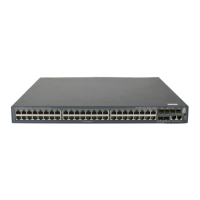49
• Configuring or changing the device ID of a switch logs out all online users of the switch.
• HP recommends to save the configuration and reboot the switch after configuring or changing the
device ID.
• The device ID is the symbol for stateful failover mode. Do not configure any device ID for a switch
working in stand-alone mode.
To specify the device ID used in stateful failover mode:
Step Command Remarks
1. Enter system view. system-view N/A
2. Specify the device ID used
in stateful failover mode.
nas device-id device-id
By default, a switch works in standalone
mode and has no device ID.
Configuring a switch as a RADIUS server
RADIUS server functions configuration task list
Task Remarks
Configuring a RADIUS user Required
Specifying a RADIUS client Required
Configuring a RADIUS user
This task is to create a RADIUS user and configure a set of attributes for the user on a switch that serves
as the RADIUS server. The user attributes include the password, authorization attribute, expiration time,
and user description. After completing this task, the specified RADIUS user can use the username and
password for RADIUS authentication on the switch.
You can use the authorization-attribute command to specify an authorization ACL and authorized VLAN,
which is assigned by the RADIUS server to the RADIUS client (the NAS) after the RADIUS user passes
authentication. The NAS then uses the assigned ACL and VLAN to control user access. If the assigned
ACL does not exist on the NAS, ACL assignment fails and the NAS forcibly logs out the RADIUS user. If
the assigned VLAN does not exist on the NAS, the NAS creates the VLAN and adds the RADIUS user or
the access port to the VLAN.
To configure a RADIUS user:
Step Command Remarks
1. Enter system view.
system-view N/A
2. Create a RADIUS user and
enter RADIUS server user
view.
radius-server user user-name No RADIUS user exists by default.

